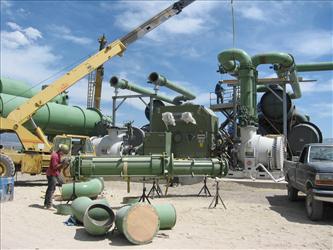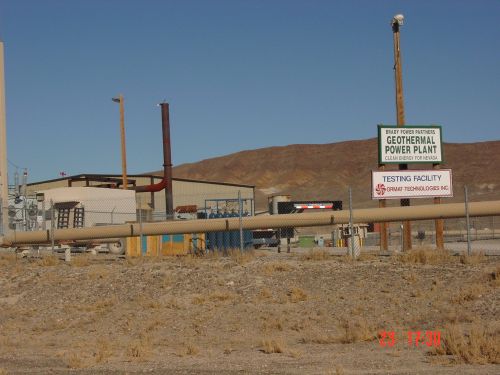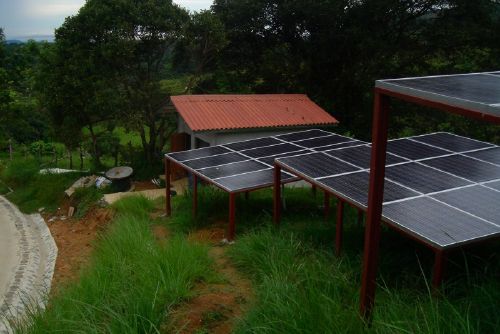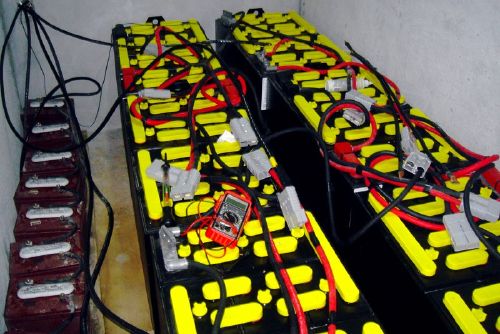Blog Archives
Geothermal Power: It’s Hot!
This short film was Produced by Frank DiMassa and T.H. Culhane (narrated by T.H.) Sure, it’s a little cheesy, but you can get a look around a Geysers dry steam plant and it does hit the high points on the benefits of geothermal power.
HT: Yahoo Geothermal Energy Group Comments are off for this post
Raft River Unit One Complete
Last week US Geothermal announced that the construction phase of the 13MW Raft River One Unit is now completed. After a little more testing, the facility will enter production (although the test power is being sold presently according to the company.) Congratulations to US Geothermal on making the leap from developer to operator.

Photo Credit: US Geothermal
Seeking Alpha on Ormat

Photo Credit: Mike Harding
Via Seeking Alpha:
On December 17, Ormat Technologies Inc. (NYSE:ORA) announced a 20-year agreement with Southern California Edison for the sale of energy from ORA’s 30 megawatt plant at Imperial Valley, CA, that is expected to come on line by mid 2012. On December 18, Ormat announced the execution of agreements in the 340 MW Sarulla Geothermal Project in Indonesia where Ormat will design and supply the power generating units. These agreements indicate that ORA will not only remain as a leading geothermal power producer in US, but is also expanding its international presence.
…
The stock has been making good gains (almost 70%) since June ’07 lows. This gain has resulted in the stock breaking out of a prolonged consolidation that extended for almost a year and a half. The lofty PE (95 and 45 – Trailing and Forward respectively; Source: Yahoo Finance) makes the stock appears expensive at current levels. Nevertheless, considering the business opportunities available for ORA, any dip on the stock can be a buy opportunity for short and medium-term players. The Reno, NV based company’s policy of targeting an annual payout ratio of at least 20% of its net income (ORA has been distributing regular quarterly dividends for the last three years) makes the stock attractive for those who want a steady stream of income.
We agree that Ormat is an impressive player in the geothermal space, and the largest and most stable pure play. However, we believe the stock is tremendously expensive (even accounting for prospects and growth) at present levels.
One aspect of the company not covered in the article is the split between the equipment and electricity generation segments. We believe the equipment and electricity operations segments in the same company will prove to be problematic strategically as customers of the equipment segment increasingly see the electricity segment as a competitor. The equipment segment is about 20% of the company’s revenue and is “lumpy” from quarter to quarter. The electricity segment is where the growth is occurring. We wonder if it might not make more sense to spin out the equipment business as an “arms” dealer to all, including a separate Ormat run electricity generator.
All that being said, geothermal is the renewable that has yet to be discovered in the mainstream and it may be that there is substantial upside still possible in the stock given the overall heat of the segment. As an additional data point, traditional electricity generators trade at a PE of around 15 (Source: Yahoo Finance.)
Disclosure: The author holds no position in Ormat.
Multi-dimensional harvest in Panama
A colleague of ours has been exploring Panama recently and brought Rancho de Caldera to our attention. It’s a small resort set in the mountains of Panama with nine cabins and it’s largely energy independent. Despite being close to a volcano, geothermal systems are not part of the harvest system (even for heating/cooling), rather it is solar, wind, and micro hydro harvest backed by a battery bank and supplemented by a generator. The operator estimates that between 4.5 – 5 kW of electricity are generated per hour (1 kW from hydro/wind and the balance from solar.)

Photo Credit: Rancho de Caldera

Photo Credit: Rancho de Caldera
$1 per watt solar

Photo Credit: Nanosolar Blog
Last week, much ink (pun intended) was spilled regarding Nanosolar’s announcements regarding their new printed solar cell technology. The first 3 panels were presented one to stay at company HQ, one to the San Jose tech museum, and one to be auctioned by eBay (not!, read the blog on that story…)
We’ve been a bit bearish on photovoltaic solar for two primary reasons: cost and capacity. If the breakthroughs claimed by Nanosolar prove out in practice (there is precious little technical information available about the printed solar cells performance) then it’s possible the cost aspect of our bearish outlook has been cracked. The pricing places these panels in the capital cost class of plain coal (as opposed to “clean coal”) and natural gas fired technologies. That is significant.
The capacity aspect is still problematic, here in North America around 40 degrees north, one can expect an average capacity factor in a good solar location to come out at 24%; peaking at ~36% in the summer and bottoming out at ~12% in the winter. When looking at solar relative to fossil fuels, hydro, nuclear, and geothermal, all baseload technologies, this aspect is still a barrier. However, at the new price point, the major advantage solar pv has is in small, distributed installations which are impractical for the baseload technologies and that advantage can now be maximized.
The missing link is the technical details. State-of-the-art pv loses around 1% efficiency per year of use, is that true of Nanosolar? What is the conversion efficiency? Silicon-based pv cells have gone north of 40% in the lab and are commercially available around ~20%. Thin film cells check in around 10%. Based on what has been disclosed about the technology it’s likely to be closer to thin film than silicon in efficiency. Until these details become clear and the breakthrough can be judged publicly against known technology, it’s exciting potential. We’ll be anxiously waiting to see the details.








